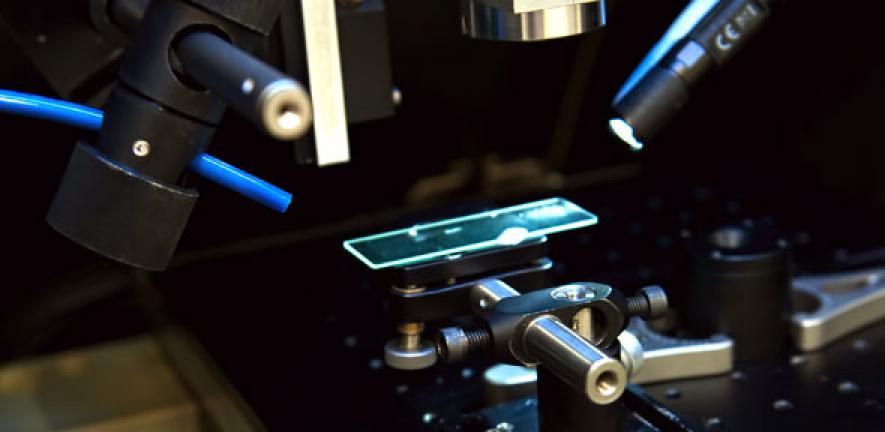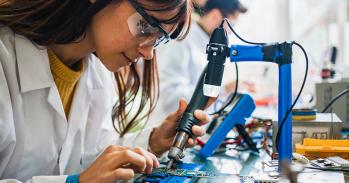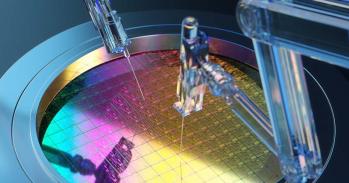
Developing advanced materials is only part of the journey that leads to new technologies – we also need to manufacture them with ultra precision. The Centre for Innovative Manufacturing in Ultra Precision aims to help companies become ‘precision-ready’.
Developing advanced materials is only part of the journey that leads to new technologies – we also need to manufacture them with ultra precision. The Centre for Innovative Manufacturing in Ultra Precision aims to help companies become ‘precision-ready’.
Having done so much of the materials research in this country, we need to capitalise on it by creating production-level competencies
Bill O'Neill
Are you happy with your smartphone? Professor Bill O’Neill, Director of the Institute for Manufacturing’s (IfM) Centre for Industrial Photonics, isn’t. He’s looking ahead to the next generation of ‘personal assistants’ that will monitor your heart rate, tell you how much alcohol you have in your bloodstream or give you a complete check-up by analysing the chemistry of your sweat. This phone will have a whole array of miniature sensors and microprocessors embedded in it derived from the latest breakthroughs in microelectromechanical systems technology.
But to make devices like these requires extraordinary levels of precision – the ability to manufacture intricate features that are smaller than 100 nanometres.
Diagnostic smartphones are just one example of the new kinds of products that are going to need ultra precision manufacturing. The emergence of polymer or carbon-based semiconductor materials like graphene is driving research and development in areas such as the production of lower cost, more efficient solar cells and ‘printed electronics’ that can be used for flexible display screens and smart labelling. But, for these devices to become reality, companies are going to need a whole new set of production capabilities.
The ultra precision research carried out by O’Neill and his team at the IfM is focused on building these kinds of machines and developing the associated systems and processes that can make things at nano levels of precision.
As O’Neill is quick to emphasise, it is critical for the UK economy that we invest in the manufacturing capabilities as well as doing the baseline research. “Having done so much of the materials research in this country, we need to capitalise on it by creating production-level competencies. If we don’t invest in this now, we’ll end up without a significant foothold in production. This was exactly what happened with semiconductors even though the UK carried out much of the underlying research in the 1960s. We can’t allow the same thing to happen with the polymer electronics industry and the new opportunities that are coming with carbon and graphene science. This is the case we put to the government.”
In 2011, the Engineering and Physical Sciences Research Council awarded funding of £6 million to the Centre for Innovative Manufacturing in Ultra Precision, a joint venture between the University of Cambridge and Cranfield University.
“Cranfield has decades of experience of designing machines, including some of the most precise machine tools in the world,” said O’Neill. “By virtue of the extensive materials research taking place across the University, we have much more experience of working with the new generation of unconventional semiconductor materials. We also have laser and focused ion beam, or FIB, machinery so can provide new energy sources for processing materials. The partnership with Cranfield coupled with the cross-Cambridge collaborations creates a very strong team with the potential to transform the way we think about and make the next generation of products.”
The research carried out by the Centre is focused on three key areas. The first is looking at ‘roll-to-roll’ printed electronics whereby conductive inks are printed onto rolls of plastic, optical film and other flexible materials. This process promises mass production at a fraction of the cost of producing conventional electronics and the ability to print onto large and flexible materials has obvious benefits for display systems.
The second area is based around more conventional machine systems but ones that can produce very precise mechanical components with accuracies of a few tens of nanometres. At the moment these machines are huge but the new systems being designed at Cranfield are very compact with extremely high levels of accuracy and efficiency.
Thirdly, the IfM team is developing a hybrid of FIB and laser technology. Semiconductor materials are usually processed using FIBs but the process is slow. The new system will increase efficiency by three orders of magnitude, transforming what was a high precision but low productivity system into a high precision and high productivity system.
These three research ‘platforms’ are focused on developing the underlying machine capability. Over and above these is a growing number of research projects looking at the devices these machines can make and how the new materials they are working with respond to these production processes.
The Centre benefits from the involvement of industrial research partners including Carl Zeiss, Jaguar Land Rover, Oxford Instruments and the National Physical Laboratory. Working with industry and building a much bigger, highly connected ultra precision community to help develop a fully fledged manufacturing capability in the UK is one of the Centre’s key aspirations. One obstacle it needs to overcome is that many companies using ultra precision processes do not consider themselves to be within the ultra precision ‘sphere’. The Centre has started a national outreach programme with the aim of creating an effective national hub for industry and academia where knowledge and resources can be shared to mutual advantage.
As O’Neill describes it: “The endgame for us is to provide industry with a wide range of experts in various disciplines that are centred around the design, development and production of ultra precision products and processes.”
Extracted from an article published in IfM Review.
The text in this work is licensed under a Creative Commons Licence. If you use this content on your site please link back to this page. For image rights, please see the credits associated with each individual image.





